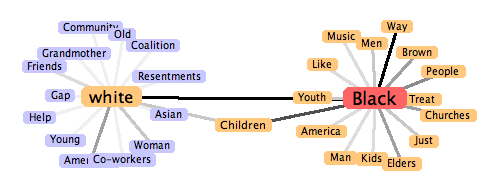Stéfan Sinclair and I have just finished writing up an essay from an extreme text analysis session, Now, Analyze That. It is first of all a short essay comparing Obama and Wright’s recent speeches on race. The essay reports on what we found in a two day experiment using our own tools and it has interactive handles woven in that let you recapitulate our experiment.
The essay was written in order to find a way of write interpretative essays that are based on computer-assisted text analysis and exhibit their evidence appropriately without ending up being all about the tools. We are striving for a rhetoric that doesn’t hide text analysis methods and tools, but is still about interpretation. Having both taught text analysis we have both found that there are few examples of short accessible essays about something other than text analysis that still show how text analysis can help. The analysis either colonizes the interpretation or it is hidden and hard for students and others to recapitulate. Our experiments are therefore attempts to write such essays and document the process from conception (coming up with what we want to analyze) to online publication.
Doing the analysis in a pair where one of did the analysis and one documented and directed was a discovery for me. You really do learn more when you work in a pair and force yourself to take roles. I’m intrigued at how agile programming practices can be applied to humanities research.
This essay comes out of our second experiment. The first wasn’t finished because we didn’t devote enough time together to it (we really need about two days and that doesn’t include writing up the essay.) There will be more experiments as the practice of working together has proven a very useful way to test the TAPoR Portal and think through how tools can support research all the way through the life of a project, from conceptualization to publication. I suspect as we try different experiments we will be changing the portal and the tools. too often tools are designed for the exploratory stage of research instead of the whole cycle right to where you write an essay.
You can, of course, actually use the same tools we used on the essay itself. At the bottom of the left-hand column there is an Analysis Tool bar that gives you tools that will run on the page itself.

“We’re striving for a rhetoric that doesn’t hide text analysis methods and tools, but is still about interpretation.”
Fascinating. I have often wondered if the ultimate text analytical article would be one in which text analysis isn’t mentioned. After all, I say almost nothing of my “methodology” when I write a conventional scholarly article (at least in English studies). I simply assert that this text says this thing, that there are more instances of this than that, or whatever it might be. One could, of course, argue that I *am* revealing my methodology with such statements (and in things like the work cited page), but it’s nothing like what happens in your article, where you say things like “This is what happened when we looked at x.” That would be a very strange thing to say in a conventional critical article. Also strange would be things like “We conclude with a view of the collocates . . try it yourself!”
I don’t offer any of this as a critique, really. I just want to know why you have the goals you do, and if you can derive any general principles that might help to achieve those goals — assuming, of course, that the goals are worthy ones.
We have a couple of goals. One is to experiment with the rhetoric of the text analysis essay (in the French sense of experiment). We have a draft that explains some of this, There’s a Toy in My Essay. Of course, like any open research essay we reserve the right to change our minds entirely.
One way to put it is that we aren’t happy with the two extremes. On the one hand people hide their methods, and on the other you get the New York Times Flash toys with no interpretation.
Another goal was to take text analysis project quickly through from conception to “publication”. Because we are trying to iterate quickly we settled on short blog-like web essays as the publication, not critical essays. But this is an experiment (the second actually) and again, we reserve the right to change our mind. Once we have tried a number of different types of interations we will be in a better position to reflect on text analysis itself, though you will find reflections in our note.